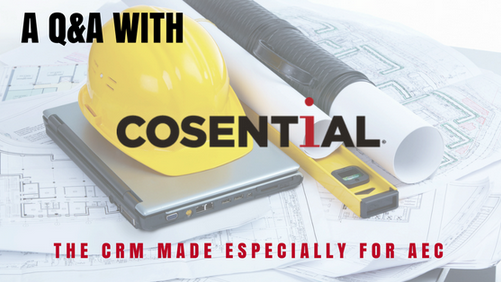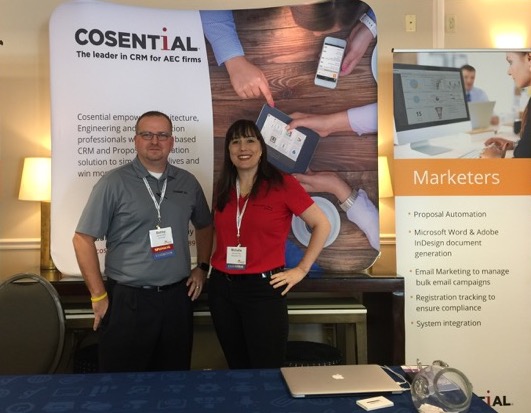A Q&A with Cosential: The CRM made especially for AEC
Our team recently had the pleasure of mingling with movers and shakers in the architecture, engineering and construction (AEC) industry at the SMPS SunBuilt conference, an annual regional event for AEC marketing and business development professionals.
One of those people was Bobby Hollis, VP of Marketing for Cosential, a CRM and proposal tool for AEC firms. We wanted to pick Bobby’s brain about what the industry-specific CRM means for AEC lead-generation efforts. Luckily, he agreed (without us pinning him down).
Here are some takeaways from our conversation with Bobby:
REPUTATION INK: What aspects of Cosential are unique to the AEC market (as compared to another CRM system that is not targeted to a particular market)?
BOBBY: Cosential is made to sell projects, experience and relationships — not products. And part of what makes that possible and streamlined for AEC teams is the nomenclature that reflects the way AEC teams speak, act and work. For example, leads graduate into “projects” instead of “customers” or “sales.”
“Cosential is made to sell projects, experience and relationships — not products.”
REPUTATION INK: How does that help with qualifying leads?
BOBBY: Take the go/no-go test: in a traditional product-driven CRM, the value of the pipeline is defined by the dollar amount of the potential sale. For AEC companies, multi-million “no-go” projects would look like a whole lot of lost opportunity in the pipeline. In Cosential, the lead value is based on opportunities that actually matter to AEC sales (estimated cost, value of partnership, project timeframe), not just the contract amount. So essentially, there are quantifiable ways to address if it’s a “go.”
REPUTATION INK: Can you talk about some other major functionalities of Cosential that are valuable to AEC firms?
BOBBY: There are three pillars to Cosential: the actual CRM, the proposal automation and the email marketing.
The proposal automation is a game-changer. For many AEC marketers, the proposal development process in an inefficient beast full of duplicative, unnecessary tasks — the marketer must bug each individual team member to get resumes, architect information, awards, photography, partner certifications, similar completed projects, etc. Incredibly, marketers have often told me that they end up going back through InDesign files to find critical information written in the file margin notes. But Cosential documents all of the projects in the cloud so all of that is available at their fingertips, eliminating the tedious back-and-forth feedback process.
Our email marketing functionality is similar to that of MailChimp or Constant Contact — it allows for meaningful content to be sent out at the right time and to the right people. Marketing and sales teams can target by criteria (e.g. job title), document those interactions and also measure metrics like open-rates and bounce-rates. And it all works in conjunction with the CRM.
“There are three pillars to our CRM: the actual CRM, the proposal automation and the email marketing.”
REPUTATION INK: What would a salesperson from another CRM, say Salesforce, argue to contradict the importance of an industry-specific system like Cosential?
BOBBY: Salesforce would say that an AEC firm can customize the CRM for its needs. For example, Salesforce’s AppExchange is basically a marketplace where companies can buy and sell Salesforce-compatible apps and add-ons. This is great for many industries, but Cosential has all of the necessary “extras” AEC firms would need already built into it (without the stuff they wouldn’t). Many of the firms we talk to have hired Salesforce consultants or bought every relevant add-on and customization just to do their jobs. And every time without fail, these same firms regret not having found Cosential before putting in all of that work (and money).
REPUTATION INK: What is a typical timeframe to implement Cosential versus a system that is not customized for the AEC industry?
BOBBY: An aggressive timeframe for a typical CRM is six months to a year. Cosential’s implementation period is one to three months.
REPUTATION INK: How do you improve the product and stay current in the fast-changing SaaS market?
BOBBY: Our team doesn’t sit around in a smoky room alone thinking of better ways to enhance the system — in fact, 100 percent of our product update ideas are from clients’ suggestions. We take every piece of feedback seriously, weigh the impact of those ideas, prioritize them and implement 10 to 20 new updates every two weeks. Cosential is not only for AEC, but by AEC.
“Cosential is not only for AEC, but by AEC.”
Here are two great examples: Our Quick Search functionality was suggested by a client. This tool is modeled after Google’s intelligent, auto-completion search capabilities. With a comprehensive, alphabetized search index, users can pull data such as leads, opportunities, companies’ projects or contacts. This is important for AEC firms given the high volume of acronyms and specific language in the industry.
The “Client Excellence Tab” is another idea that will be launched soon – and it was literally written on a napkin. This will be a grid on the main dashboard showing a quick view of important client information such as project managers and year-to-date revenue, allowing you to quickly prioritize and interact with various data points.
REPUTATION INK: As a CRM provider for the AEC market, do you have insight into how AEC firms are marketing and generating leads?
BOBBY: I recently served as a judge in the SMPS Marketing Communications Awards. Through that experience, I saw first-hand how several AEC firms are creating high-quality content, from video to newsletters. However, there’s a lot of room for growth, particularly in content and inbound marketing. Many firms are doing well solely based on their reputation, word of mouth and existing relationships, but those things alone won’t make them leaders in the long run.
“Many firms are doing well solely based on their reputation, word of mouth and existing relationships, but those things alone won’t make them leaders in the long run.”
REPUTATION INK: We’ve seen a lot of AEC firms relying on old-school practices and hesitating implementing modern marketing approaches — can you talk a little more about why that is, and what the future looks like?
BOBBY: For one, the construction industry is lagging behind in technology adoption. A lot of this is due to legacy mindsets — older generations who are just starting to hand over business operations to the newer, more tech-savvy leaders. For instance, we hear from people every day who are still using Outlook and Excel for everything, and they need to make their database shareable and accessible in order to collaborate better. Getting rid of clunky software and processes is definitely an early step in the right direction.
In business development, there’s a big move away from the doer-seller; now, it’s more about dividing and conquering, with an increased specialization of roles (i.e. salespeople focused purely on bringing in new business). This is a widely practiced strategy in other industries, but one in which the AEC industry is just now playing catch up.
Ultimately, AEC firms need to get comfortable using tried-and-true “old-school ways” with modern lead-generation tactics in order to move ahead of their competition.
REPUTATION INK: Do you think AEC firms could benefit more from content marketing specifically?
BOBBY: The short answer: Yes.
The long answer: Unfortunately, content marketing has not been a priority for those holding the purse strings (i.e. the C-suite). Content marketing is definitely something that many small to mid-sized firms want to do, but don’t have the time or resources to invest in and do effectively. Though I see a lot of larger firms doing it well, firms of any size have the potential to gain more rapport and trust in the space by making content marketing a priority, especially when they can hire an agency instead of building an in-house team.
Visit cosential.com to learn more about what Bobby touched on in our chat.










